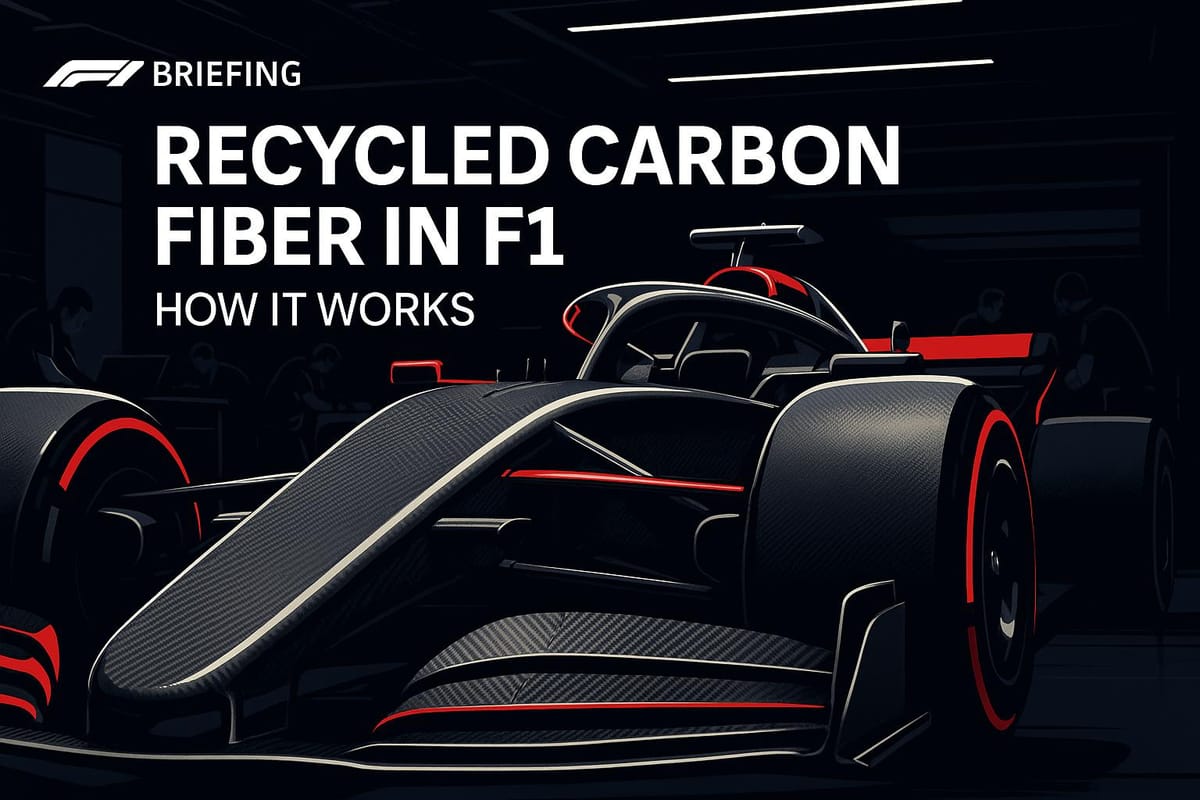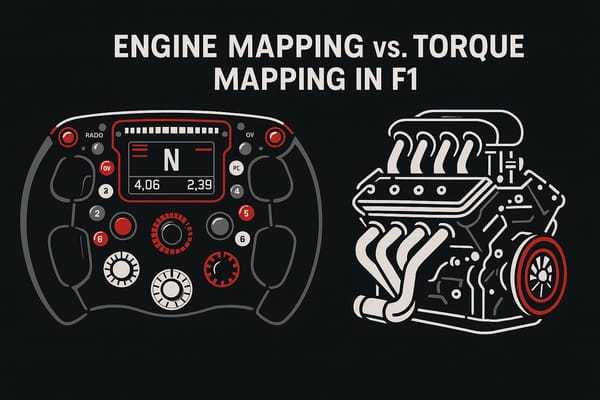Recycled Carbon Fiber in F1: How It Works
Recycled carbon fiber in Formula 1 is revolutionizing sustainability, offering lower emissions while maintaining performance. Learn how teams are making the shift.

Recycled carbon fiber is transforming Formula 1, offering up to 90% lower emissions compared to new material, while retaining up to 95% of its original strength. F1 teams are now exploring ways to integrate recycled carbon fiber into car components, balancing performance with sustainability. Here's what you need to know:
- Why it matters: Carbon fiber makes up 75-85% of F1 cars but is energy-intensive to produce. Recycling reduces waste and emissions.
- Recycling methods: Techniques like pyrolysis and advanced heating preserve fiber strength for reuse in structural and non-structural parts.
- Current use: Teams like McLaren have tested recycled carbon fiber in non-critical parts, with promising results.
- Challenges: High-performance demands, supply chain gaps, and material consistency need to be addressed.
F1's push for recycled carbon fiber is part of its goal to reach net-zero emissions by 2030, setting a new standard for motorsport and beyond.
Inside F1's first-ever recycled carbon fibre trial #USGP
How Carbon Fiber Gets Recycled
Recycling carbon fiber involves several specific methods, each tailored to meet the high-performance standards of Formula 1 while addressing environmental concerns. As the sport shifts toward more sustainable practices, teams are adopting these processes to strike a balance between performance and responsibility.
Mechanical Recycling
Mechanical recycling takes a straightforward route by shredding carbon fiber waste into reusable particles without separating the fibers from the polymer matrix. This process begins with shredding and sieving the material to standardize particle sizes, producing both long-fiber and short-fiber reinforced materials. These materials can then be reprocessed using techniques like compression or injection molding. However, the trade-off is a significant loss in strength. Dr. Di He from UNSW Canberra explains:
"The mechanical performance of objects made from the existing recycled fibres is degraded by 80 to 90 per cent, compared to using new fibers".
Because of this reduction in mechanical properties, mechanically recycled fibers are typically limited to non-structural components in F1 cars.
Pyrolysis Process
Pyrolysis offers a more advanced approach by using controlled heat to break down the polymer matrix while preserving the integrity of the carbon fibers. In this method, pre-sized carbon fiber is heated in an oxygen-limited environment, causing the polymer to decompose into gases, vapors, and char. The fibers are then purified to retain their mechanical strength, and the byproducts can be captured for energy recovery.
Mitsubishi Chemical Advanced Materials (MCAM) has refined this process, incorporating thermic post-combustion of pyrolysis gases to reduce CO₂ emissions while recovering high-quality fibers. Tim Rademacker, General Manager of Carbon Fiber Recycling at MCAM, highlights the broader impact:
"As a part of the Mitsubishi Chemical ecosystem, our recycled carbon fiber contributes to the creation of a more conscientious value chain for our customers".
Pyrolysis not only delivers high-quality fibers but also offers cost savings of 20–40% compared to virgin carbon fiber. Considering that over 30% of carbon fiber produced ends up as waste, this method aligns recycling efficiency with F1’s high-performance demands.
New Recycling Technologies
Emerging technologies are pushing carbon fiber recovery even further. High-power laser systems now enable the localized degradation of multi-layered fiber-reinforced plastics, allowing for the recovery of continuous carbon fibers without compromising their quality. Dr. Di He's research team has developed an optimized heating method that avoids shredding the fibers. He explains:
"In our method we don't shred the carbon fibre and we optimised how we heat it in a furnace...This leaves the fibres intact, and therefore the new product made from the recycled carbon fibre is much stronger".
This method reduces fiber degradation to less than 30%, which is a 50% improvement over existing techniques.
F1 teams are already adopting these cutting-edge methods. Starting in 2025, the Mercedes-AMG Petronas Formula One Team plans to incorporate sustainable carbon fiber composites into its cars, using recycled fibers and bio-based resins to create a closed-loop recycling system. Meanwhile, the Fraunhofer EMI project has developed a unique approach that combines pyrolysis with the unwinding of fiber rovings. Mathieu Imbert, the project manager, describes the process:
"What makes this process special is that we perform pyrolysis of the matrix and unwinding of the fiber roving simultaneously at a reasonable speed without damaging the carbon fibers".
The reclaimed continuous fibers from this method perform on par with new fibers, making them suitable for demanding applications.
These advancements have made recycled carbon fiber a practical option for structural uses in F1. Recycled fibers require only about one-fifth of the energy needed to produce new ones, and some recycling methods retain approximately 95% of the tensile strength of virgin fibers. Jacob Tidy, a Composites Apprentice at McLaren, emphasizes this potential:
"This unlocks the potential to use it in other areas of the car, considering that the mechanical properties are near enough the same as normal carbon fibre".
With these innovations, recycled carbon fiber is becoming an increasingly viable material for F1 car structures, paving the way for a more sustainable future in racing.
Using Recycled Carbon Fiber in F1 Cars
Formula 1 teams are working closely with material experts and the FIA to test recycled carbon fiber, ensuring it meets the demanding safety and performance standards required for racing. By leveraging advanced recycling technologies, these teams are beginning to explore how this material can contribute to sustainability efforts on the track.
Structural and Non-Structural Components
F1 parts are generally divided into two categories: structural and non-structural. Recycled carbon fiber is currently best suited for non-structural components like body panels, cockpit branding, and aerodynamic fairings. On the other hand, structural parts - such as the monocoque chassis, roll hoops, and suspension mounting points - play a critical role in driver safety and require materials that meet the highest safety and performance benchmarks.
Nikolas Tombazis from the FIA explains the challenge:
"The high-performance requirements of components in Formula 1 means that specialist, non-recyclable materials are extensively used at present, which is a challenge we must look to solve collectively as an industry. Additionally, sustainable materials - such as recycled carbon fibre or natural fibres - often fall short of meeting safety, weight and performance standards".
However, advancements in recycling technology are starting to change this dynamic. Recent trials have shown that recycled carbon fiber can reduce lifecycle emissions by 90% compared to traditional carbon fiber - saving an impressive 27 tons of carbon emissions for every ton of material used. Considering that carbon fiber composites make up around 75% of an F1 car's structural components, the potential environmental impact of adopting recycled materials is significant.
McLaren Racing's recent efforts provide a concrete example of how this shift is being approached.
Case Study: McLaren's Use of Recycled Carbon Fiber

In October 2023, during the United States Grand Prix, McLaren Racing became the first F1 team to use recycled carbon fiber in a race setting. Partnering with V Carbon, they tested the material on the cockpit branding panels of their MCL60 cars. This deliberate choice allowed them to validate the material in a non-critical application before considering broader uses.
Krzys Kaczmarski, McLaren's Senior Sustainability Manager, described the strategy:
"We're using them on non-structural, non-safety critical parts to prove that it works. This will prove that it's fit for purpose and that it is good enough to be used on a Formula 1 car".
The trial was a success, with the recycled carbon fiber delivering the required performance while maintaining its environmental advantages. Lando Norris's second-place finish at the event further demonstrated its reliability in high-pressure conditions.
McLaren sees this trial as part of a larger vision for sustainability in F1. Piers Thynne, the team's Chief Operating Officer, emphasized the importance of this development:
"We're proud to team up with V Carbon to lead the charge in sustainable materials, running with recycled carbon fibre at the Austin GP. The potential future applications of rCF are hugely exciting. V Carbon offers up to 85% of carbon fibre original strength, making it strong enough for a variety of applications in F1, and beyond. We will continue to work closely with the FIA, F1 and fellow teams to help accelerate change."
Kim Wilson, McLaren Racing's Director of Sustainability, added:
"Developing a fully circular F1 car is our moonshot. We know that innovating in this space has the potential to make a large contribution to achieving our ambitious sustainability goals. As a team, we are passionate about driving change in our sport but we cannot do this alone and need to collaborate with others, like V Carbon and our partners Deloitte, to achieve this. Using recycled carbon fibre in key parts of the F1 car at this year's US GP and analysing their performance on the track is a vital step towards reducing the overall GHG emissions of our car manufacture. V Carbon's new technology, as with many other pioneering developments in F1, also has the potential for wider application across other industries, so we're excited to explore next steps."
McLaren's approach - starting with non-critical components and expanding applications as data supports their performance - provides a roadmap for how other teams might adopt recycled materials. This strategy not only addresses the FIA's concerns about sustainable materials but also aligns with the sport's relentless pursuit of high performance.
Benefits of Recycled Carbon Fiber
Recycled carbon fiber is gaining traction in Formula 1 as teams strive to balance environmental responsibility with economic efficiency. This material not only helps reduce emissions but also eases cost pressures, especially under tight budget caps.
Lower Carbon Emissions
Recycled carbon fiber significantly reduces lifecycle emissions - by up to 90% - saving 27 tonnes of CO₂ for every tonne of material produced. To put this into perspective, even a modest 1% global recycling rate in 2022 could have prevented between 32,535 and 70,848 tonnes of CO₂ emissions. Considering that carbon fiber constitutes nearly 75% of an F1 car, the potential impact is enormous.
Krzys Kaczmarski, Senior Sustainability Manager at McLaren, highlights the environmental benefits:
"Everything has a carbon footprint. When you take a raw material and manufacture it, especially something very complex like carbon fibre which has a lot of different components, all of those raw materials have to be extracted, processed and transported, and there's energy and fuel that go into all of those things. We're also then using energy to dispose of it. If you recycle that piece of carbon fibre, then you're skipping a lot of those steps."
This approach aligns with Formula 1's ambitious goal of achieving net-zero carbon emissions by 2030. Similarly, McLaren is targeting a 50% reduction in its greenhouse gas footprint by 2030, with plans to reach net-zero by 2040.
The push for sustainable materials extends beyond Formula 1. In 2024, Dallara partnered with Tenowo to create a Formula 2 safety seat made entirely from recycled, needle-punched nonwoven carbon fiber. This innovation slashed CO₂ emissions by 97.5% compared to seats made from virgin carbon fiber, cutting the carbon output from 40 kilograms per kilogram of material to just 1 kilogram. Dallara has already incorporated this material into the front wing components for its F2 and F3 cars.
While the environmental advantages are clear, recycled carbon fiber also presents a strong economic case for racing teams.
Cost Savings for Teams
In addition to its environmental benefits, recycled carbon fiber offers teams a chance to cut costs. By using recycled materials, teams can save up to 30% on raw material expenses.
James Key, a Technical Director in Formula 1, emphasized the financial importance:
"With the introduction of the budget cap, the cost of materials is going to be a big focus and the use of natural fiber composites has the potential to help in this area."
Christian Fischer, CEO and Co-Founder of Bcomp, expanded on the advantages of sustainable materials:
"We match conventional carbon fiber while lowering the eco footprint by 75%, cutting costs, reducing vibrations and improving safety – all of which are highly relevant to achieving a sustainable future for motorsport and mobility."
Other sustainable materials, like flax fibers, further enhance cost efficiency. Flax fibers are 9% lighter and offer five times better vibration damping than traditional carbon materials. This eliminates the need for additional damping systems, leading to further savings.
Looking ahead, the Mercedes-AMG Petronas Formula One Team plans to start incorporating sustainable carbon fiber composites into its race cars for the 2025 season. With strict budget constraints in place, even small savings on materials can free up resources for other critical development areas. This makes recycled carbon fiber not just an eco-friendly choice, but a strategic advantage for teams aiming to excel in a competitive and cost-sensitive environment.
Future of Recycled Carbon Fiber in F1
The potential for recycled carbon fiber in Formula One is exciting, but there are still some significant hurdles to clear before it becomes a standard material in the sport. Teams are actively working on cutting-edge recycling methods while tackling issues like performance demands and supply chain limitations. Let’s dive into the latest advancements and the obstacles that remain.
New Recycling Technology Developments
Recycling technology is evolving rapidly, offering new ways to recover and reuse carbon fiber in F1. For instance, HRC in Jiangsu, China, has introduced patented microwave pyrolysis technology. This method minimizes fiber degradation to less than 30%, which is a 50% improvement compared to older techniques. Other innovations, like low-temperature resin infusion and bio-resin development, are also making recycled fibers more durable and cost-efficient .
VCARB, working with Holy Technologies, is taking a fresh approach to carbon fiber manufacturing. Paolo Marabini, chief designer at VCARB, shared:
"Holy Technologies is taking a different approach to the manufacturing process that is normally used for carbon fiber components. It opens up the opportunity to reuse the same carbon fiber and therefore has the potential to significantly reduce the overall amount of material we use for our car components, while at the same time optimizing the performance of those components."
These advancements include extracting high-quality fibers from retired F1 parts for reuse in new components. There’s also progress in creating bio-resins from renewable sources and developing ultra-fast curing epoxy composites, nanocomposites, and smart metal composites. Early defect detection systems are being adopted to ensure recycled materials meet the rigorous safety and performance standards required in F1 .
Barriers to Wider Use
Despite these breakthroughs, there are still several challenges slowing the adoption of recycled carbon fiber in Formula One. One major issue is the lack of a well-developed supply chain. As Andrew Maxey, CEO of Vartega, puts it:
"Without the right pieces coming together you can have the best technology in the world, but you're not going to have material to recycle and you're not going to have any products to put it in."
The extreme performance demands of F1 components also present a hurdle. According to the FIA, "the high-performance requirements of components in Formula 1 means that specialist, non-recyclable materials are extensively used at present, which is a challenge we must look to solve collectively as an industry".
Another concern is consistency. While recycled carbon fiber can be about 40% cheaper than virgin material, ensuring uniform mechanical properties across batches remains difficult. This variability makes teams hesitant to fully embrace recycled components, which slows progress toward F1’s sustainability objectives.
Overcoming these challenges will require collaboration across the sport. Krzys Kaczmarski from McLaren highlights the importance of working together:
"A more circular economy is essential to decarbonising not only us as McLaren Racing but also the sport and industry more widely... We really want to throw our weight behind these developing technologies so that they can scale and develop to the point where they can be used across the grid."
Conclusion
Recycled carbon fiber is poised to make a major impact on Formula 1, offering a significant reduction in lifecycle emissions - up to 90%. For every ton of recycled carbon fiber used, 27 tons of CO₂ emissions are saved. Even with just a 1% recycling rate, this could prevent over 32,000 tons of emissions annually.
Recent examples highlight its readiness for real-world use. McLaren's trial during the October 2023 US Grand Prix and Dallara's fully recycled safety seat show that recycled carbon fiber can meet the rigorous performance and sustainability requirements of F1. These aren't just experimental efforts - they demonstrate that the technology is ready to be scaled.
Collaboration within the industry is key. Both McLaren and the FIA have stressed the importance of building strong recycling supply chains and maintaining high material standards. Kim Wilson, McLaren Racing's Director of Sustainability, captured this vision:
"Developing a fully circular F1 car is our moonshot. We know that innovating in this space has the potential to make a large contribution to achieving our ambitious sustainability goals".
As global demand for carbon fiber is projected to hit 262,000 tons by 2025, the widespread use of recycled carbon fiber in F1 could deliver substantial environmental benefits. This shift underscores F1's dedication to innovation - not just in performance but also in sustainability. By embracing recycled materials, the sport is setting a powerful example for the broader automotive industry, paving the way for greener, more responsible manufacturing.
FAQs
How does using recycled carbon fiber in F1 cars affect their performance and safety?
Recycled carbon fiber (rCF) plays an important role in Formula One, retaining about 85% of the strength of virgin carbon fiber. This makes it ideal for keeping F1 cars lightweight and durable - two critical factors for success on the track. Lightweight materials enhance performance, improving aerodynamics and fuel efficiency, while the durability of rCF ensures safety, offering strong structural integrity during high-impact crashes.
Beyond performance, rCF significantly reduces the sport's carbon footprint. It can cut lifecycle emissions by up to 90% compared to traditional carbon fiber. By incorporating rCF, Formula One aligns with its sustainability goals and drives progress in recyclable materials, setting a precedent for a more environmentally conscious future in motorsport.
What challenges do F1 teams face when using recycled carbon fiber in their cars?
F1 teams encounter a host of hurdles when trying to integrate recycled carbon fiber into their cars. One major obstacle is the weakened material strength that comes with the recycling process. Unlike new carbon fiber, recycled versions tend to have lower tensile strength, which can compromise the performance and safety of essential car components. This means engineers must work meticulously to ensure these materials still meet the rigorous demands of F1 racing.
Another significant issue is the complex and costly recycling process. Unlike metals, recycling carbon fiber composites is far less straightforward and requires more resources. Teams need to invest in cutting-edge technologies and innovative methods to make these materials usable while balancing sustainability goals with the intense performance requirements of the sport.
What are the environmental advantages of using recycled carbon fiber in F1 compared to traditional methods?
Using recycled carbon fiber in Formula One brings major environmental benefits compared to traditional carbon fiber production. Recycling can cut greenhouse gas emissions by as much as 90% over its lifecycle, which translates to saving about 27 metric tons of carbon emissions per car. On the other hand, producing traditional carbon fiber requires a lot of energy and generates a hefty amount of emissions.
The recycling process itself is more energy-efficient and uses fewer resources, making it a smarter choice for F1 teams aiming to lower their carbon footprint. This approach aligns with F1's sustainability goals while still delivering the high-performance materials essential for building race cars.




